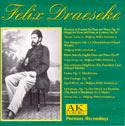Felix
Draeseke:
Six Songs Op. 2: Book I
Märzblumen
(March Blossoms)
|
Lieder:
Märzblumen (March Blossoms) (All poems by Adolf Stern) |
|
|
Listen to one of the Märzblumen Lieder (Hochflut, op 2, vol 1, nr 6) Märzblumen
Lieder: Texts with English Translations
|
The Lieder in Draeseke's Op. 2 really encompass three books. Book 2 and Book 3 met peculiar fates which will be dealt with somewhat later. Practically all the songs were done in 1860-1861, that is, in the final full year of his homeland residence before he moved to the French part of Switzerland in September, 1862. There is a total of 15 songs in the three books of Op. 2. The Märzblumen, Op. 2, Book 1 had the greatest success and they occupy an important place in the early creativity of the composer. Here the 36 year old, fully manifesting the highly individual compositional qualities which were prized so highly by Wagner, Liszt and other “New Germans” that he was nicknamed “der Recke” – literally “the daredevil” – and which singled him out as a most promising adherent of the New German School. The listener of today may be excused if he senses something slightly disturbing, questionable, unexpected or puzzling in these songs. That is just part of the general joy in discovering the musical personality of this budding genius. Wolfgang Müller-Steinbach, the pianist/accompanist on the AKCoburg CD, has written the following:
One should also note something here about the completely forgotten poet whose texts Draeseke chose to set. Adolf Stern was born in 1835 in Leipzig, that is, in the same year as Felix Draeseke himself and died in 1907 in Dresden, Draeseke’s long time final residence. Draeseke had a predilection for Stern’s poetry and there are actually more song texts by Stern than by any other poet in Draeseke’s song catalog. To be sure, they knew one another and were good friends in real life. Today the name Adolf Stern seems to have been expunged from the literary lexicons and is rarely encountered. Even in his lifetime he did not receive great attention (e.g. one is hard put to find anything by him in the innumerable lyric breviary so popular with good German bourgeois households at the end of the 19th century). As a publicist and literary historian he was able to maintain himself professionally however. |
| Lieder:
Märzblumen, Op. 2, Heft 1 (Sämtliche Gedichte von
Adolf Stern) 1. Gegrüßt, gegrüßt ihr vollen Fluten, 2. Vergessen, 3. März, 4. Lenz, 5. Ich schau in dein Auge voll Glanz und Glut, 6. Hochflut |
|
|
Listen to one of the Märzblumen Lieder (Hochflut, op 2, vol 1, nr 6) Märzblumen
Lieder: Texts with English Translations
|
Die Lieder in Draesekes Op. 2 umfassen eigentlich drei Hefte. Die Heft 2 und Heft 3 erfuhren seltsame Schicksale, die später erwähnt werden. Fast alle Lieder wurden 1860-1861 entworfen, also im letzten vollen Jahr als Draeseke in Deutschalnd lebte, ehe er sich im September 1862 in die französische Schweiz begab. Insgesamt gibt es in den drei Heften von Op. 2 fünfzehn Lieder. Die Märzblumen, Op. 2, Heft I haben den größten Erfolg gehabt und nehmen einen wichtigen Platz im Frühschaffen des Komponisten ein.Hier zeigt sich „der Recke“, 36 Jahre alt, in der vollen Bahn seiner kompositorischen Eigenarten, derjenigen die Wagner, Liszt und die Neudeutschen hoch schätzten und die den noch jungen Komponisten als vielversprechend auszeichneten. Der moderne Zuhörer dürfte entschuldigt werden, wenn das Leichtstörende, das Fragliche, das Unerwartete oder das Rätselhafte in diesen Liedern ihre Gegenwart merken lassen. Das ist aber wohl die Freude am Entdecken in der musikalischen Persönlichkeit dieses jungen Genies. In bezug darauf schreibt der Klavierbegleiter an unserer CD, Wolfgang Müller-Steinbach das Folgende:
Man sollte hier auch etwas über den völlig vergessenen Dichter berichten, dessen Texte Draeseke zu vertonen wählte Adolf Stern (d.i.: Adolf Ernst) wurde 1835 in Leipzig geboren, also in demselben Jahr wie Felix Draeseke selbst, und ist 1907 in Dresden gestorben. Draeseke hatte eine Vorliebe für Sterns Dichtung und es gibt tatsächlich mehr Liedtexte von Stern im Liederkatalog Draesekes als von irgendeinem anderen Dichter. Zwar kannten die beiden einander und sie waren wirklich gute Freunce das ganze Leben hindruch. Heute begegnet man dem Namen Adolf Stern in den Dichterlexika kaum mehr. Auch zur Lebzeit konnte er sich keines großen Ruhms erfreuen (z.B. man findet seine Lyrik fast nie in den Hunderten von Liederhorten des ausgehenden 19 Jahrhunderts, welche zum guten bürgerlichen Haushalt gehörten). Doch als Publizist und Literaturhistoriker konnte er sich professionell durchhalten. © Alan
Krueck 2003 |
| Draeseke's Märzblumen on CD: | |
Listen to one of the Märzblumen Lieder (Hochflut, op 2, Book 1, nr 6) |
Adagio for Horn and Piano, op. 31 (1885); Romanze for Horn and Piano, op. 32 (1885); Fata Morgana, op. 13 (1877); Kleine Suite for English Horn and Piano, op. 87 (1911); Das verlassene Mägd'lein, op. 2: Vol II nr 5; Märzblumen Lieder, op. 2: Book I; Drei Gesänge, op. 76 (1906); Der Mönch von Bonifazio, melodrama after C.F.Meyer, op. 74 Wolfgang Müller-Steinbach [piano], Thomas Crome [horn], Georg Lustig [english horn], Ingrid Würtz [soprano], Helmut Loos [narrator] |
[Chamber Music] [Orchestral Music] [Keyboard Music] [Audio Samples] [Video] [Top]
© All contents copyright by the International Draeseke Society
